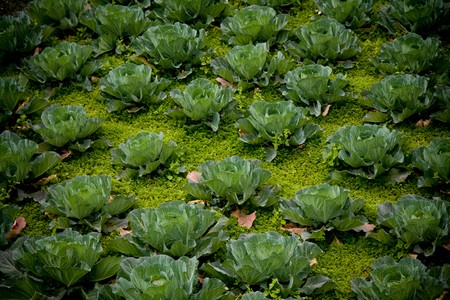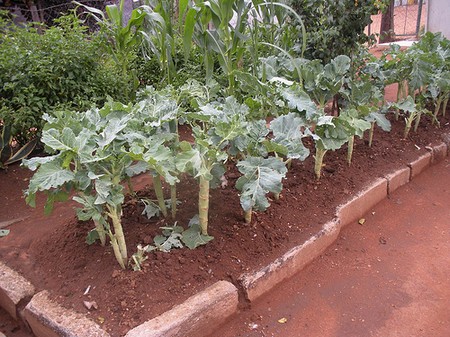Best Way to Prevent Problems When Growing Cabbages
Cabbages and their relatives (broccoli, Brussels sprouts, calabrese, cauliflower, kale, oriental greens, swede and turnip) can suffer from a large number of pests and diseases. Fortunately, most can be prevented by non-chemical methods and good planning. Cabbage root fly grubs live in the soil and feed on the roots of young plants. Severe attacks can stunt or even kill the plants. You can prevent the adult flies from laying their eggs by pushing young plants through cabbage collars. These are 15-cm diameter circles of flexible material, e.g. carpet underlay, which lie flat on the soil.
An easier method on a vegetable plot is to cover the whole bed with garden fleece, or fine netting supported on plastic hoops. Provided the edges are well secured, this will prevent the flies getting anywhere near your crop. It will also stop other flying pests such as the flea beetle, mealy cabbage aphids and cabbage white butterflies. Cabbage white caterpillars feed voraciously on the leaves of all members of the cabbage family from mid-summer onwards. Check leaves regularly before infestations of caterpillars have a chance to build up. Rub off the tiny eggs or pick off the caterpillars (for the bird table). Caterpillars can be killed by spraying with a contact insecticide. One based on pyrethrum is acceptable in organic gardens. The biological control BT is a solution of a bacterium that kills caterpillars, but is harmless to all other creatures.
Clubroot affects not only all the edible members of the cabbage family, but related ornamentals too, such as wallflowers and stocks. It is caused by a fungus that can survive in the soil for up to 20 years. Despite feeding and watering, leaves of infected plants will turn red or purple and the plants will wilt on hot days. Dig up the plant and you will find the characteristic swollen and distorted roots.
While a three- or four-year crop rotation may help to prevent a build-up of the disease, once it appears in your garden this will not help to eradicate it. If the disease is restricted to one area, try growing members of the cabbage family on a different part of the garden. Be careful not to transfer soil around the garden, even on your boots. Destroy all affected plants, preferably by burning. Do not compost them.
Even if you have clubroot in your soil, there are several precautions you can take to ensure a reasonable crop:
- Clubroot is less severe in alkaline soil, so liming during the winter to raise the pH to 7.5 will help. Some gardeners take cabbage family plants out of the crop rotation and grow them on the same area year after year. By keeping the plot alkaline through regular liming, they manage to live with clubroot.
- Raise all plants in pots and pot on into 10- or 15-cm pots containing multipurpose compost. Plant these out; the plants should be sufficiently well developed before the roots contact the fungus, that you will still get a crop. Cabbages grown in containers should not be affected unless infected garden soil is used. Watch out for signs of the disease in ornamental borders; it will also affect related flowers growing there.
- No varieties of broccoli, Brussels sprouts, cabbage, cauliflower, kale or oriental greens are resistant to clubroot, though spring cabbage, which does most of its growing in autumn and winter, may avoid the disease. There are resistant varieties of calabrese and swede.
Flea beetles are small yellow and black beetles that pepper leaves with little holes. Seedlings and young plants are most at risk, in spring and early summer. Unless damage is severe, the plants generally grow out of danger. In severe cases, dust around vulnerable plants with derris. As the beetles hibernate in the soil, crop rotation combined with a covering of garden fleece should offer complete protection.
Categories
Advertisements
Recent Articles
 How to Understand Bed Sizes – A Small Guide
How to Understand Bed Sizes – A Small Guide How to Select Some Must Have Kitchen Accessories
How to Select Some Must Have Kitchen Accessories Best Way to Change a Car Tire
Best Way to Change a Car Tire Best Way to Write an Affirmation
Best Way to Write an Affirmation Best Way to Take Charge of Your Financial Life
Best Way to Take Charge of Your Financial Life Best Way to Survive a Party When You Don’t Know Anyone
Best Way to Survive a Party When You Don’t Know Anyone Best Way to Stop Self Sabotaging Yourself
Best Way to Stop Self Sabotaging Yourself Best Way to Start Journal Writing
Best Way to Start Journal Writing Best Way to Speak with a Powerful Voice
Best Way to Speak with a Powerful Voice Best Way to Simplify Your Life
Best Way to Simplify Your Life Best Way to Respond to a Put-Down
Best Way to Respond to a Put-Down Best Way to Reduce Acne Breakouts
Best Way to Reduce Acne Breakouts Best Way to Recover from Dining Disasters
Best Way to Recover from Dining Disasters Best Way to Quit Your Job Gracefully
Best Way to Quit Your Job Gracefully Best Way to Make Your Own Website
Best Way to Make Your Own Website




Leave a Reply